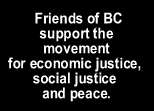
|
|||||||||||||||||||||||
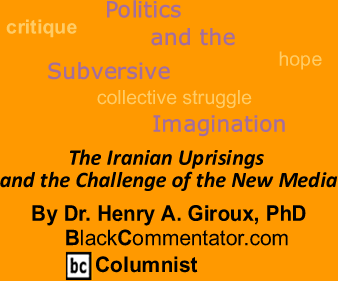
|
|

Custom Search
|
|
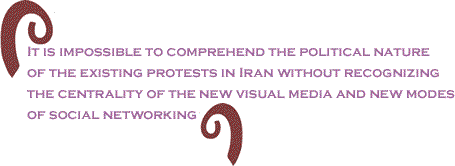 |
|
[We welcome Dr. Henry A. Giroux, PhD, as the newest BlackCommentator.com Columnist.] As
the uprisings in Increasingly, reports are emerging in the press and other media outlets of a number of protesters being attacked or killed by government forces. In the face of massive arrests by the police and threats of execution from some government officials, public protest continues even, as Nazila Fathi reports in the New York Times, the government works “on many fronts to shield the outside world’s view of the unrest, banning coverage of the demonstrations, arresting journalists, threatening bloggers and trying to block Web sites like Facebook and Twitter, which have become vital outlets for information about the rising confrontation here.” [3] It is impossible to comprehend
the political nature of the existing protests in
The pedagogical force of culture
is now writ large within circuits of global transmission that
defy the military power of the state while simultaneously reinforcing
the state’s reliance on military power to respond to the external
threat and to control its own citizens. In
A spectacular flood of images produced by a subversive network of technologies that open up a cinematic politics of collective resistance and social justice now overrides Iran’s official narratives of repression, totalitarianism, and orthodoxy–unleashing the wrath of a generation that hungers for a life in which matters of dignity, agency, and hope are aligned with democratic institutions that make them possible. Death and suffering are now inscribed in an order of politics and power that can no longer hide in the shadows, pretending that there are no cracks in its body politic, or suppress the voices of a younger generation emboldened by their own courage and dreams of a more democratic future. In this remarkable historical moment, a sea of courageous young people in Iran, are leading the way in instructing an older generation about a new form of politics in which mass and image-based media have become a distinctly powerful pedagogical force, reconfiguring the very nature of politics, cultural production, engagement, and resistance. Under such circumstances, this young generation of Iranian students, educators, artists, and citizens are developing a new set of theoretical tools and modes of collective resistance in which the educational force of the new media both records and challenges representations of state, police, and militia violence while becoming part of a broader struggle for democracy itself. Any critical attempt to engage
the courageous uprisings in Demonstrations of solidarity
are emerging between the Iranian diasporia and students and other
protesters within
The rise of the new media and the conditions that have produced it do not sound the death knell of democracy as some have argued, but demand that we “begin to rethink democracy from within these conditions.” [7] These brave Iranian youth are providing the world with a lesson in how the rest of us might construct a cultural politics based on social relations that enable individuals and social groups to rethink the crucial nature of what it means to know, engage civic courage, and assume a measure of social responsibility in a media-saturated global sphere. They are working out in real time what it means to address how these new technologies might foster a democratic cultural politics that challenges religious fundamentalism, state censorship, militarism, and the cult of certainty. Such a collective project
requires a politics that is in the process of being invented,
one that has to be attentive to the new realities of power, global
social movements, and the promise of a planetary democracy. Whatever
the outcome, the magnificent and brave uprising by the young people
of
As these students and young people have demonstrated, it would be a mistake to simply align the new media exclusively with the forces of domination and commercialism as many do in the United Sates – with what Allen Feldman calls “total spectrum violence.” [8] The Iranian uprising, with its recognition of the image as a key force of social power, makes clear that cultural politics is now constituted by a plurality of sites of resistance and social struggle, offering up new ways for young people to conceptualize how the media might be used to create alternative public spheres that enable them to claim their own voices and challenge the dominant forces of oppression. Theorists such as Thomas Keenan, Mark Poster, Douglas Kellner, and Jacques Derrida are right in suggesting that the new electronic technologies and media publics “remove restrictions on the horizon of possible communications” [9] and, in doing so, suggest new possibilities for engaging the new media as a democratic force both for critique and for positive intervention and change. The ongoing struggle in Iran, if examined closely, provides some resources for rethinking how the political is connected to particular understandings of the social; how distinctive modes of address are used to marshal specific and often dangerous narratives, memories, and histories; and how certain pedagogical practices are employed in mobilizing a range of affective investments around images of trauma, suffering, and collective struggles.
[This commentary was originally published in CounterPunch.] BlackCommentator.com
Guest Commentator, Henry A. Giroux holds the Global TV Network
chair in English and Cultural Studies at McMaster University in
Canada. Related work: Henry A. Giroux, “The Mouse that Roared: Disney and the End of Innocence ” (Lanham:
Rowman and Littlefield, 2001). His most recent books include “Take Back Higher Education” (co-authored with Susan Searls
Giroux, 2006), “The University in Chains: Confronting the Military-Industrial-Academic
Complex” (2007) and “Against the Terror of Neoliberalism: Politics Beyond the Age of
Greed” (2008). His newest book, “Youth in a Suspect Society: Democracy or Disposability? Notes: [1] I take up the issue of screen culture and the
challenge of the new media in Henry A. Giroux, Beyond
the Spectacle of Terrorism: Global Uncertainty and the Challenge
of the New Media (The Radical Imagination) ( [2] I want to thank Tony Kashani for these figures. [3] Nazila Fathi, “Protesters Defy Iranian Efforts to Cloak Unrest,” New York Times (June 18, 2009), p. A1. [4] Brian Stelter and Brad Stone, “Stark Images of
the Turmoil in [5] Ibid., Stelter and Stone, “Stark Images of the
Turmoil in [6] Thomas Keenan, “Mobilizing Shame,” South Atlantic Quarterly 103, no. 2/3 (2004), p. 447. Keenan explores the relationship between ethics and responsibility in even greater detail in his Fables of Responsibility (Stanford: Stanford University Press,1997). [7] Jacques Derrida cited in Michael Peters, “The Promise of Politics and Pedagogy in Derrida,” Review of Education/Pedagogy/Cultural Studies (in press). [8] Allen Feldman, “On the Actuarial Gaze: From 9/11 to Abu Ghraib,” Cultural Studies 19, no. 2 (March 2005), p. 212. [9] Jürgen Habermas, The Theory of Communicative Action, Volume 2: Lifeworld and System: A Critique of Functionalist Reason, (This link is to the Kindle edition - hardcover and paperback unavailable from Amazon.com) trans. Thomas McCarthy (Cambridge, UK: Polity Press, 1987), p. 390. |
|
Any BlackCommentator.com article may be re-printed so long as it is re-printed in its entirety and full credit given to the author and www.BlackCommentator.com. If the re-print is on the Internet we additionally request a link back to the original piece on our Website. Your comments are always welcome. eMail re-print notice
If you send us an eMail message we may publish all or part of it, unless you tell us it is not for publication. You may also request that we withhold your name. Thank you very much for your readership. |
|
| |
|
| June
25 , 2009 Issue 330 |
|
| Executive Editor: Bill Fletcher, Jr. |
| Managing Editor: Nancy Littlefield |
| Publisher: Peter Gamble |
| Est. April 5, 2002 |
Printer Friendly Version
in resizeable plain
text format or pdf
format. |
| Frequently Asked Questions |
 |

|
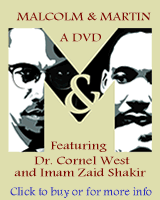 |
 |
 |
| |
| |





























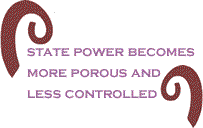 The
Internet, YouTube
The
Internet, YouTube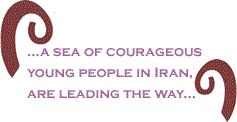 The
endless flashing of screen culture not only confronts those in
and outside of Iran with the reality of state sponsored violence
and corruption but also with the spread of new social networks
of power and resistance among young people as an emerging condition
of contemporary politics in Iran. Text messaging, Facebook, Twitter,
YouTube, and the Internet have given rise to a reservoir of political
energy that posits a new relationship between the new media technologies,
politics and public life. These new media technologies and Websites
have proved a powerful force in resisting dominant channels of
censorship and militarism. But they have done more in that they
have allowed an emerging generation of young people and students
in
The
endless flashing of screen culture not only confronts those in
and outside of Iran with the reality of state sponsored violence
and corruption but also with the spread of new social networks
of power and resistance among young people as an emerging condition
of contemporary politics in Iran. Text messaging, Facebook, Twitter,
YouTube, and the Internet have given rise to a reservoir of political
energy that posits a new relationship between the new media technologies,
politics and public life. These new media technologies and Websites
have proved a powerful force in resisting dominant channels of
censorship and militarism. But they have done more in that they
have allowed an emerging generation of young people and students
in 
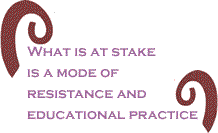 The
uprising in
The
uprising in 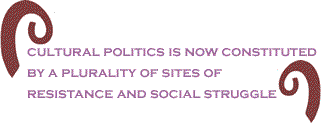
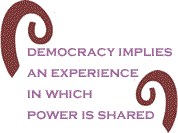 The
images and messages coming out of
The
images and messages coming out of 

